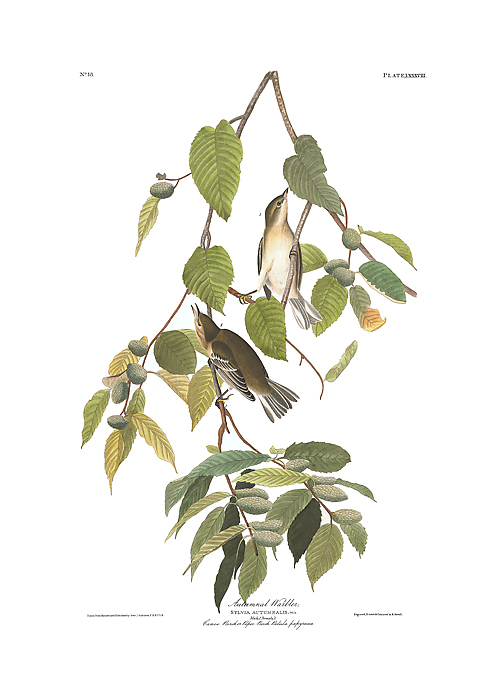
|
|
|
|
Havell Name
Autumnal Warbler
Common Name
Bay-breasted Warbler
Havell Plate No.
088
Paper Size
39" x 28"
Image Size
18" x 11"
Price
$ 600
|
|
|
Ornithological Biography
The Autumnal Warbler was so named by Mr. Wilson on account of its appearing in the neighbourhood of Philadelphia, where only it was seen by that writer, during its migration from the northern States, where it breeds, to the confines of Mexico, its winter residence.
This species makes its appearance in great numbers, in the lower parts of Louisiana, earl in March, and remains there for a few days along with many others. At this season it passes from the top of one high tree to that of another, with great activity. In about a week after its first appearance none are to be seen. It moves towards the northernmost of our eastern districts, as the season advances, and does not stop until it reaches the remote parts of the State of New York, many individuals, however, forcing their way still further.
I have found it breeding in the immediate vicinity of the Cayuga lakes, and on the borders of Lake Champlain, in retired parts of the woods, which it seems to prefer during summer months. I have also found it in the lofty forests of that portion of Pennsylvania usually called the Great Pine Swamp. The nest, like that of many other Sylviae, is partially conical and pensile, and is formed of the soft bark of vines, lined with the down of various plants. The eggs are from four to six, of a white colour, tinged with red, and sprinkled with brownish dots at the larger end. The nest is usually placed in the slender fork of a low bush. I have found the female sitting as late as the 20th of August, and therefore conclude that this species raises two broods in the season, although I have had no opportunity of finding the nest and eggs at an earlier period.
The food of the Autumanl Warbler consists of small insects, many of which it procures whilst on wing. It also searches with great industry among the leaves and along the twigs. Its habits are precisely similar to those of other Warblers. Its flight is short, unequal, and yet quick. It rises in the air to some distance, and returns towards the spot which it has left, in zigzag lines, as if it were afraid to venture out of the thickets which it inhabits.
No sooner have these birds reared their young than they assemble in large, loose parties of fifty or more, and return towards the south, throwing themselves amongst the Willows and Birch-trees that margin the streams, as well as into orchards and the scattered trees in cultivated fields. Its common note is a simple tweet, but the male, in the spring and during the period of incubation, repeats at short intervals a soft and pleasing variety of notes, scarcely, however, deserving the name song.
These birds are so plentiful, and so easily found, from the middle of September to that of October, that while in the Great Pine Forest I sometimes shot more than a dozen in a day. I have never observed them in the Southern State at that season.
I have represented a pair of these plain-looking Warbler on a twig of the Canoe Birch, a tree too well known, from the use to which its bark is applied by the Indians in the construction of their light and beautiful boats, to require any particular description here.
SYLVIA AUTUMNAL, Ch. Bonaparte, Synops. of Birds of the United States, p. 74.
AUTUMNAL WARBLER, SYLIVA AUTUMNALIS, Wils. Amer. Ornith. Vol. iii p. 65. Pl. 23. Fig. 4.
Adult Male. Plate LXXXVIII. Fig. 1.
Bill of ordinary length, nearly straight, slender, tapering, acute. Nostrils basal, lateral, elliptical, half-closed above by a membrane. Head and neck of ordinary size. Body slender. Feet longish, slender; tarus longer then the middle toe, covered anteriorly with a few scutella, the uppermost long; toes scutellate above, the inner free, the hind toe of moderate size; claws slender, compressed, acute arched.
Plumage loose blended. Short bristly feathers at the base of the bill. Wings rather short, the first quill longest. Tail even.
Bill brown, the lower mandible yellowish towards the base. Iris hazel. Feet dusky. The general colour of the upper parts is light olive-green. The tail-coverts grayish. A pale line over the eye, which is encircled by a narrow line of whitish. Fore neck dull yellow; under parts generally yellowish-white. Quills and larger coverts dusky on their inner webs, the former margined, the latter tipped with white, so as to present two bans of that colour across the wing. Tail dusky, margined with dull white, the three outer feathers white on the greater part of their inner web.
Adult Female. Plate LXXXVIII. Fig. 2.
The female resembles the male in external appearance.
CANOE BIRCH OR PAPER BIRCH
BETULA PAPYRACEA, Willd. Sp. Pl. vol. iv. P. 464. Pursh, Flor. Amer. Vol. ii. P. 621. Mich. Arbr. Forest. De l’Amer. Sept. vol. ii. P. 133. Pl. 1.-MONCEGIA POLYANDRIA, Linn. AMENTACECE, Juss.
Leaves ovate, acuminate, doubly serrated, the veins hairy beneath, the petiole smooth. The female catkins pedunculate, pendent. This tree is most abundant in the northern States, where it sometimes attains a height of from seventy to eighty feet, and a diameter of three feet.
|
Back
|
|
|



